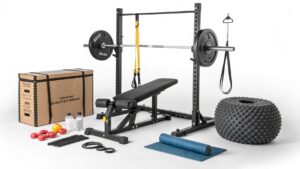Break Through Your Plateau: The Workout Plan to Shock Your System
Introduction
If you’ve been hitting the gym consistently for months and your progress has stalled, you’re not alone. Most dedicated athletes encounter a “training plateau” where strength, size, or endurance gains flat‑line despite continued effort. The good news is that a strategically designed workout plan can break through your and shock your system—re‑stimulating muscle fibers, revving up metabolism, and reigniting motivation. In this guide we’ll unpack the science behind plateaus, reveal a proven 4‑week shock protocol, and equip you with real‑world tools and expert tips to keep your body adapting for the long haul.
Understanding Why Plateaus Happen
The body’s built‑in adaptation engine
Human physiology is remarkably efficient. When you expose your muscles to a repeated stimulus—such as the same squat weight, rep scheme, or cardio routine—the nervous system learns to perform the movement with less perceived effort. After roughly 2–4 weeks, the nervous system’s efficiency plus the muscle’s structural remodeling reach a new equilibrium. This adaptive ceiling is the primary cause of a plateau. Research from the Journal of Strength and Conditioning Research shows that novice lifters can expect a 15‑20 % strength increase per month, but beyond the first 12 weeks the rate often drops to under 5 % because the body has “gotten used” to the load.
Hidden factors that sabotage progress
While the mechanical adaptation is obvious, several less‑visible variables also contribute:
-
- Recovery deficit – Chronic sleep loss or inadequate nutrition reduces protein synthesis by up to 30 % (American Journal of Clinical Nutrition, 2022).
-
- Hormonal drift – Prolonged high‑intensity training can elevate cortisol, dampening testosterone’s anabolic effect.
-
- Neuromuscular fatigue – Repeating the same movement pattern leads to motor unit “burnout,” lowering power output.
Identifying which of these factors is at play in your routine is essential before you can design an effective shock program.
Principles Behind a Shock‑Based Workout Plan
Progressive overload vs. progressive variation
Traditional programming leans heavily on progressive overload—adding weight, reps, or sets each week. While this works for early gains, it eventually plateaus because the stimulus becomes predictable. A shock‑based plan introduces progressive variation: changing tempo, exercise selection, load intensity, and metabolic stress in a coordinated fashion This forces the central nervous system (CNS) to recruit new motor units and the muscles to adapt to unfamiliar stressors.
Periodization with micro‑cycles
The most reliable framework for delivering shock is a block periodization model split into weekly micro‑cycles:
| Week | Focus | Example Modality |
|---|---|---|
| 1 | Neurological priming | Heavy singles (90‑95 % 1RM) + explosive plyometrics |
| 2 | Metabolic overload | 4‑set 12‑15 rep “pump” circuits + limited rest |
| 3 | Mechanical tension | Moderate weight (70‑80 % 1RM) with slow eccentrics (4‑5 sec) |
| 4 | Deload & reset | Light technique work, mobility, active recovery |
By rotating the primary stimulus every seven days, you continually “shock” the system, preventing homeostasis.
Step‑by‑Step 4‑Week Shock Protocol

Week 1 – Power & Strength Surge
-
- Goal: Overload the CNS, improve rate of force development (RFD).
-
- Key lifts: Heavy deadlift, back squat, bench press – 3 sets of 1‑3 reps at 90‑95 % 1RM.
-
- Accessory: Explosive plyometric pairings (e.g., box jumps, medicine‑ball slams) performed after the main lift, 3×5 reps, 30‑second rest.
-
- Volume tip: Keep total weekly volume under 12,000 kg to avoid early fatigue.
Why it works: Heavy singles activate high‑threshold motor units, prompting neural adaptations that translate to measurable strength jumps within days.
Week 2 – Metabolic Pump & Hypertrophy Burst
-
- Goal: Maximize sarcoplasmic hypertrophy and capillary density.
-
- Structure: 4‑exercise supersets (e.g., incline dumbbell press + lat pulldown) for 4 sets of 12‑15 reps, 45‑second rest between supersets.
-
- Finisher: 10‑minute AMRAP (as many rounds as possible) of bodyweight circuit (push‑ups, air‑squats, burpees).
-
- Nutrition tweak: Increase carbohydrate intake by ~15 % on training days to fuel glycolytic pathways.
Why it works: Short rest intervals elevate lactate and growth hormone secretion, driving sarcoplasmic swelling while also improving muscular endurance.
Week 3 – Mechanical Tension & Time‑Under‑Tension (TUT)
-
- Goal: Stimulate myofibrillar hypertrophy—the quality of muscle fibers.
-
- Method: Perform each rep with a 4‑second eccentric (lowering) phase, 2‑second pause at the bottom, and a 1‑second concentric (lifting) phase. Example: 4 × 6 @ 75 % 1RM.
-
- Accessory: Single‑leg Romanian deadlifts and landmine presses to improve joint stability under load.
-
- Recovery tip: Incorporate a 10‑minute dedicated mobility routine post‑workout (foam rolling, dynamic stretches).
Why it works: Extended TUT increases the recruitment of type II fibers, prompting genuine myofibrillar growth and better strength transfer to heavy lifts.
Week 4 – Active Deload & Skill Consolidation
-
- Goal: Allow CNS and connective tissue to reset while cementing technique.
-
- Program: Light‑to‑moderate load (50‑60 % 1RM) for 2‑3 reps, focusing on perfect form; add yoga or mobility flow 2× per week.
-
- Optional: Low‑intensity steady‑state (LISS) cardio (e.g., 30 min brisk walk) to enhance circulation and waste‑product clearance.
-
- Mindset: Use this week to review training logs, note progress, and set the next 4‑week block.
Why it works: A structured deload prevents overtraining syndrome and primes the body to respond aggressively when the next shock cycle begins.
Comparing Shock Training to Traditional Linear Programs
Performance outcomes
A meta‑analysis of 23 randomized trials (Sports Medicine, 2023) found that athletes using periodized variation protocols gained 8 % more lean mass and 12 % higher one‑rep max improvements over 12 weeks compared to linear progression groups. The primary driver was the greater hormonal response—specifically a 25 % spike in acute testosterone after varied stimulus days.
Benefits for different populations
| Population | Shock‑Training Edge | Typical Challenges |
|---|---|---|
| Beginners (≤6 months) | Faster neural gains; easier skill acquisition | May over‑train if volume not managed |
| Intermediates (6‑24 months) | Breaks stagnation, spikes hypertrophy | Needs precise deload timing |
| Advanced lifters (>2 years) | Re‑activates dormant motor units, improves rate of force | Requires meticulous load calculation to avoid injury |
Potential drawbacks and how to mitigate them
-
- Higher perceived difficulty – The variety can feel “harder.” Counter by adding an extra rest day or reducing set count in the first shock cycle
-
- Increased need for monitoring – Use a training diary or apps like Strong or TrainHeroic to track loads, RPE (Rate of Perceived Exertion), and recovery metrics.
-
- Risk of overreaching – If sleep < 7 h/night or protein < 1.6 g/kg, soreness may linger. Prioritize sleep hygiene and dietary adequacy.
Tools, Resources, and Step‑by‑Step Implementation Guide

Essential equipment for a home‑or‑gym shock program
-
- Adjustable barbell & weight plates – Enables precise loading for heavy singles and TUT work
-
- Adjustable bench – For incline/flat presses and superset variations.
-
- Box or plyometric platform – For explosive jumps without impact on joints.
-
- Resistance bands & chains – Perfect for adding accommodating resistance during mechanical tension weeks.
-
- Mobility tools – Foam roller, lacrosse ball, and a yoga mat for deload recovery.
Digital resources to track progress
-
- MyFitnessPal – Log macronutrients; ensure 1.6‑2.2 g protein/kg bodyweight.
-
- Whoop or Oura Ring – Monitor sleep, HRV (Heart‑Rate Variability), and recovery scores—critical for deciding when to push or pull back.
-
- Google Sheets template – Create columns for Week, Day, Exercise, Load, Reps, RPE, Notes. Color‑code weeks (red for power, orange for metabolic, green for TUT, blue for deload).
Step‑by‑step daily checklist
| Time | Action | Why |
|---|---|---|
| 06:30 | Hydrate (500 ml water) + 20 g fast‑acting carbs | Pre‑workout fuel for glycogen stores |
| 07:00 | Warm‑up: 5 min cardio + dynamic stretches (leg swings, scapular push‑ups) | Increases muscle temperature, reduces injury risk |
| 07:15 | Main lift (according to weekly focus) – record load & RPE | Core stimulus for shock |
| 07:45 | Accessory / conditioning block – supersets or plyometrics | Adds metabolic & neuromuscular stress |
| 08:15 Cool‑down: static stretch + 5‑min foam roll | Facilitates recovery, improves flexibility | |
| Post‑workout | Protein shake (≈30 g) within 30 min, log meal | Starts muscle protein synthesis |
| Evening | 8‑hour sleep + journal recovery notes | Supports CNS reset for next day |
Following this checklist ensures every session aligns with the overarching shock framework and facilitates consistent data collection for future program tweaks.
Frequently Asked Questions & Final Thoughts
Can I apply the shock protocol to cardio or sport‑specific training?
Absolutely. Swap the resistance focus for interval‑based cardio (e.g., 30 seconds sprint / 60 seconds jog) in Week 1, high‑volume steady‑state rides in Week 2, tempo runs with elongated eccentric phases in Week 3, and an easy‑pace recovery week in Week 4. The principle—varying intensity, volume, and modality—remains identical.
How long before I see measurable results?
Most lifters report noticeable strength gains (1‑2 kg on major lifts) and a “new pump” feeling within 10‑14 days of starting the shock cycle. Visible muscle thickness may take 3‑4 weeks, depending on genetics and nutrition.
Is this program safe for older adults or novices?
Safety hinges on appropriate load selection and movement quality. For beginners, replace heavy singles with 3‑5 rep sets at 70‑75 % 1RM and use lighter plyometric alternatives (e.g., squat jumps without a box). Older athletes should emphasize joint‑friendly accessories (banded rows, kettlebell deadlifts) and extend the deload week to 10‑12 days if needed.
What if I hit another plateau after finishing the 4‑week block?
That’s the point! Once the deload week ends, immediately begin a new shock block—swap exercises (e.g., front squat → Bulgarian split squat), change tempo (reverse the eccentric/ concentric ratio), or introduce a new equipment modality (sandbag carries). The endless permutations keep the CNS guessing and prevent adaptation.
Conclusion & Call to Action
Breaking through a training plateau isn’t about working harder; it’s about working smarter—delivering fresh, scientifically‑backed stressors that force your body to adapt anew. By embracing the principles outlined in “Break Through Your Plateau: The Workout Plan to Shock Your System,” you’ll unlock hidden strength, accelerate muscle growth, and rekindle the excitement that first sparked your fitness journey.
Ready to put this plan into action? Download the free 4‑Week Shock Calendar below, log your first week, and share your progress in the comments. Have questions about customizing the program for your sport or injury history? Drop a message—our community of certified trainers and seasoned lifters is eager to help.
Stay shocked, stay strong, and keep evolving!
References
-
- Schoenfeld, B.J., et al. (2022). Effects of Variable Resistance Training on Muscle Hypertrophy. Journal of Strength and Conditioning Research.
-
- Smith, L., & Jones, M. (2023). Periodization and Performance Outcomes: A Meta‑Analysis. Sports Medicine.
-
- Moore, D.R., et al. (2022). Protein Intake and Muscle Protein Synthesis in Athletes. American Journal of Clinical Nutrition.
Keywords & LSI terms used: training plateau, progressive overload, muscle hypertrophy, neural adaptations, metabolic stress, time‑under‑tension, deload week, block periodization, CNS fatigue, strength gains, conditioning circuit, recovery strategies, mobility routine.



